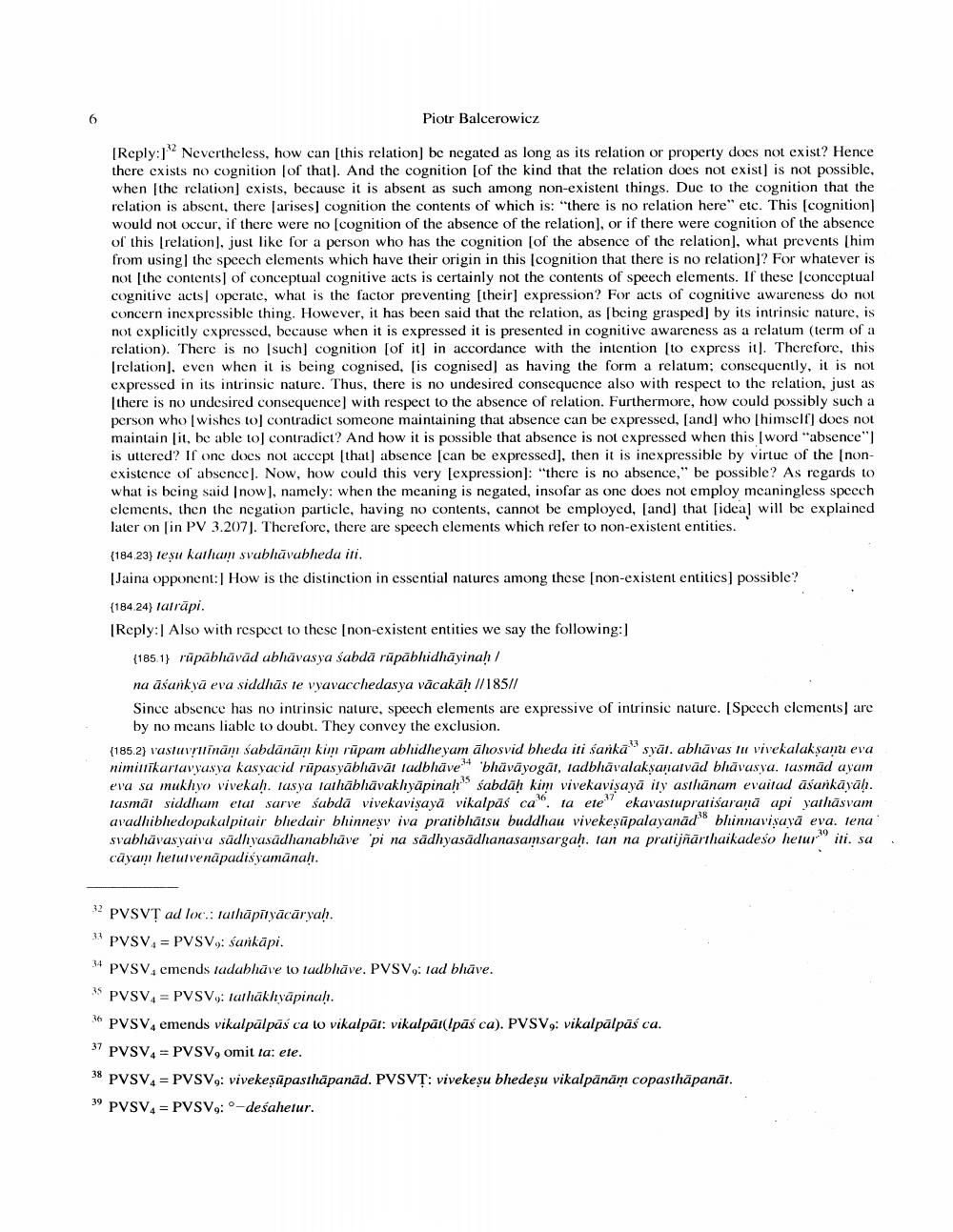________________
Piotr Balcerowicz
(Reply:]'? Nevertheless, how can [this relation] be negated as long as its relation or property does not exist? Hence there exists no cognition of that). And the cognition (of the kind that the relation does not exist) is not possible, when the relation] exists, because it is absent as such among non-existent things. Due to the cognition that the relation is absent, there arises) cognition the contents of which is: "there is no relation here" etc. This (cognition would not occur, if there were no (cognition of the absence of the relation), or if there were cognition of the absence of this [relation), just like for a person who has the cognition (of the absence of the relation], what prevents [him from using the speech elements which have their origin in this (cognition that there is no relation]? For whatever is not [the contents of conceptual cognitive acts is certainly not the contents of speech elements. If these conceptual cognitive acts operate, what is the factor preventing (their) expression? For acts of cognitive awareness do not concern inexpressible thing. However, it has been said that the relation, as [being grasped] by its intrinsic nature, is not explicitly expressed, because when it is expressed it is presented in cognitive awareness as a relatum (term of a relation). There is no such] cognition of it) in accordance with the intention to express it). Therefore, this [relation], even when it is being cognised, [is cognised) as having the form a relatum; consequently, it is not expressed in its intrinsic nature. Thus, there is no undesired consequence also with respect to the relation, just as
there is no undesired consequence) with respect to the absence of relation. Furthermore, how could possibly such a person who wishes to contradict someone maintaining that absence can be expressed, [and] who (himself] does not maintain lit, be able to contradict? And how it is possible that absence is not expressed when this word "absence") is uttered? If one does not accept (that) absence (can be expressed), then it is inexpressible by virtue of the (nonexistence of absence). Now, how could this very [expression): "there is no absence," be possible? As regards to what is being said I now), namely: when the meaning is negated, insofar as one does not employ meaningless speech elements, then the negation particle, having no contents, cannot be employed, [and] that [ideal will be explained later on sin PV 3.207). Therefore, there are speech elements which refer to non-existent entities. (184.23) Teşu katham svabhāvabheda iti. Jaina opponent:How is the distinction in essential natures among these (non-existent entities) possible? (184.24) tatrāpi. Reply: Also with respect to these (non-existent entities we say the following:
(185.1) rūpābhāvād abhāvasya sabda rüpābhidhāyinah/ na āšarkyā eva siddhās te vyavacchedasya vācakāh //185/1 Since absence has no intrinsic nature, speech elements are expressive of intrinsic nature. [Speech elements are
by no means liable to doubt. They convey the exclusion. (185.2) vastuv!llinām sabdūnām kim rūpam ablidhe yam āhosvid bheda iti sanka" syūl. abhävas tu vivekalaksanu eva nimillikariavyasya kasyacid rüpas yābhāvāt tadbhāve.'+ 'bhāvāyogāt, tadbhāvalaksanalvād bhāvasya. Tasmād ayam eva sa mukhyo vivekah. tasya tathābhāvakhyāpinah sabdāḥ kim vivekaviņayā ily asthānam evaitad āśarkāyā). Tasmãi siddham elal sarve sabdā vivekavisaya vikalpas ca ta ete" ekavastupratiśaranā api yathāsvam avadhibhedopakalpitair bhedair bhinnes iva pratibhātsu buddhau vivekesūpalayanädbhinnavisavā eva. tena svabhāvas yaiva sädhyasādhanabhāve 'pi na sādhyasādhanasamsargah. Ian na pratijñārthaikadeso heturiti sa cāyam helulvenāpadis yamūnah.
.
32 PVSVT ad loc.: luthāpītyācāryah. 3. PVSV. = PVSV,: sarkāpi.
PVSV, cmends tadabhāve to tudbhāve. PVSV.: lad bhāve. PVSV = PVSV.: lathākhyāpinah.
PVSV. emends vikalpālpās ca to vikalpāt: vikalpāt(lpās ca). PVSV,: vikalpālpās ca. 37 PVSVA = PVSV, omitta: ete. 38 PVSV4 = PVSV,: vivekesüpasthāpanād. PVSVT: vivekeșu bhede şu vikalpanām copasthāpanāt. 39 PVSV = PVSV,: -deśahetur.




